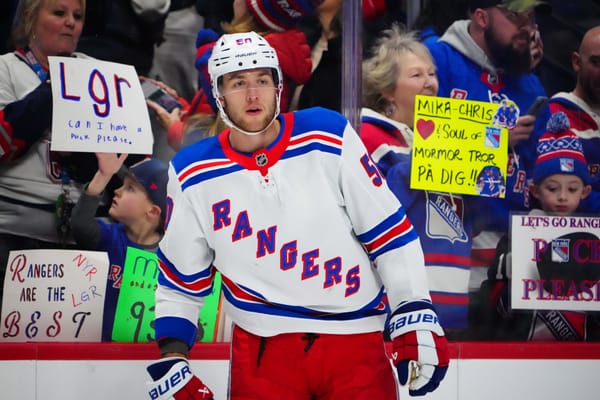Let’s Talk About KZB
The New York Rangers’ first line of Chris Kreider, Mika Zibanejad, and Pavel Buchnevich – the KZB line – has been dynamic. Glimpses of their potential were seen last season, although they didn’t have enough of a chance to show long-term success.
This line has been utilized for much of this season, both at even-strength and on the first power play unit. In the opportunities they’ve had so far this year they have excelled, proving why this combination should maintain their first-line status.
Last year, between preseason and the start of the season, the KZB line showed their skillful play. But injuries to each member of this line in the first two months of the season halted their progress. Once all three members were healthy and back in the lineup at the same time, this combination wasn’t put back together. Buchnevich was shuffled around the lineup until he found himself as a fourth-liner, and soon after a healthy-scratch, while Zibanejad and Kreider received some ice time together.
All in all, the KZB line saw 34.14 5-on-5 minutes during the 2016-17 season across 10 games. Thirty-six line combinations were utilized for at least 25 minutes of 5-on-5 play last season. The KZB line ranked highly compared to those combinations, with the sixth highest Corsi for percentage of 56.92 and third highest expected goals for percentage of 61.89. This was all accumulated in a short span, and a small sample like this isn’t necessarily indicative of how they’ll perform in a longer stretch, but it does show that the combination warranted a longer look together – especially when this team craved the offensive generation that KZB could provide.
Throughout the rest of the season, different combinations including Zibanejad, Kreider, and Buchnevich were deployed. Kreider spent the majority of the season with Derek Stepan and Mats Zuccarello on the first pair (509.9 minutes), while Zibanejad’s most frequent linemates were Kreider and Zuccarello (223.91 minutes) and Buchnevich’s longest time on a line combination was 123.58 minutes with Zibanejad and Rick Nash. Whenever any combination of Kreider, Zibanejad, and Buchnevich were on the ice together, they showed chemistry that was worth exploring further.
To start the 2017 playoffs, Buchnevich wasn’t in the Rangers’ starting lineup. But his return in Game 4 of the first round was arguably the turning point of the series. The KZB line was finally reunited and contributed to the Rangers’ series win. They didn’t last long in the second round though, as Buchnevich didn’t play much of Game 2 and was scratched for the remainder of the playoffs. All together, KZB played 40.51 5-on-5 minutes of ice time in the playoffs.
This season, many were skeptical of how Buchnevich would be utilized, especially after such a tumultuous rookie year. However, the Rangers did open the season with their best possible first line combination – Kreider, Zibanejad, and Buchnevich. This combination was also featured on the first power play unit with Zuccarello and Kevin Shattenkirk.
In the first game of the season, Zibanejad scored the Rangers’ first goal on the power play. Shattenkirk was the credited with the lone assist, but the efforts of KZB and Zuccarello were felt on this one. Moments later, Zibanejad added another power play goal, one that Zuccarello and Buchnevich assisted on. One game into the regular season, it was clear that this power play unit had the potential to be a game-changer, and that KZB looked dangerous.
Against the Toronto Maple Leafs, this power play unit scored two goals (from Shattenkirk and Zibanejad). The following game, at home versus the Montreal Canadiens, the KZB line scored a 5-on-5 goal (Zibanejad from Buchnevich and Kreider). In the Rangers’ next game, against the St. Louis Blues, the first power play unit added yet another goal (Zibanejad, assisted by Buchnevich and Shattenkirk).
Despite the KZB line producing both at even-strength and on the power play, the Rangers lost three straight games (against the Blues, Blue Jackets, and Devils). So, the lines were shuffled before their next game, when they faced the Pittsburgh Penguins. Zibanejad stayed on the first line, but had new linemates (Zuccarello and Nash). Kreider was moved to the second line with David Desharnais and J.T. Miller. And Buchnevich, most questionably of all, was moved to the fourth line with Michael Grabner and Adam Cracknell. The first power play unit was also changed, as Kreider was moved to the second unit and replaced by Nash.
Even with these changes, the Rangers still lost to the Penguins, although Buchnevich did score on first power play unit (assisted by Zibanejad and Zuccarello). Up next, the Rangers played the Islanders, and the line combinations and power play units from the previous game were maintained. No member of the KZB line tallied any points, and Buchnevich found himself at the bottom of the ice time charts.
The weakness in the Rangers’ center depth was highlighted by the next few games when only 11 forwards were deployed. Against the Predators, Buchnevich remained on the fourth line with minimal time on ice. The first power play unit didn’t produce. Zibanejad didn’t score. The only member of the KZB line to find success in this game was Kreider on the second power play unit, as he scored one on the man advantage.
Despite the lack of scoring from the first power play unit and first line, the Rangers moved into their next game against the Sharks without the KZB line until they were down 4-0 in the third period and gave them at chance at 5-on-5. Once reunited, Buchnevich assisted on Zibanejad’s goal, which ended up being the Rangers’ only goal of the night; it was just too little, too late.
Even though KZB were the only line to produce against the Sharks, it wasn’t enough to put them back together. And it also wasn’t enough to tweak the first power play unit either. But at least a fourth center, Boo Nieves, was recalled before the Rangers faced off against the Arizona Coyotes, which allowed the Rangers to roll four lines. Buchnevich skated with Nieves and Grabner, scoring one goal and assist on the fourth line. Miller was moved off Kreider’s line and switched with Zuccarello, and moved up to the first line with Zibanejad and Nash. Before going off for a line change, in the first period, Zibanejad was on the ice with Zuccarello and Kreider and assisted Kreider on the Rangers’ first goal of the night.
Although Rangers found a win versus Arizona, they still made some tweaks to their lineup for the next game, switching Zuccarello and Miller on the power play unit in Montreal. The first unit, of Miller, Nash, Buchnevich, Zibanejad, and Shattenkirk combined for one goal for (Buchnevich) in this game. And Zibanejad was able to find the back of the net at even-strength as well, but he wasn’t deployed with either Kreider or Buchnevich.
By their next matchup against the Vegas Golden Knights, there were rumors swirling about the coaches and potential trades. Coincidentally, it was a game in which the best line combinations were deployed – highlighted by a first line of KZB (one even-strength goal for) and a reunited first power play unit of KZB, Zuccarello, and Shattenkirk (two power play goals scored).
Since then, KZB and the first power play unit have stayed together. Since then, the Rangers have won five straight games, with some iteration of KZB scoring three even-strength goals (4-on-4 goal with Kreider and Zibanejad against Tampa Bay, two 5-on-5 goals against Boston mid-line change with Grabner then Vesey in Kreider’s spot for both), and the first power play unit has scored three goals.
All together this season, the KZB line have seen 107.63 5-on-5 minutes through 11 regular season games. Only eight other line combinations have played at least 20 minutes of 5-on-5 ice time – small sample alert – and no other combination has had such strong results as this line has. Together, they’ve accumulated a 56.25 Corsi for percentage (plus-11.15 relative) and 59.07 expected goals for percentage (plus-14.83 relative).
The Rangers have been missing a dangerous element up front in recent years. This is a team that’s relied on goaltender Henrik Lundqvist to mask their defensive deficiencies and keep games within reach, especially when they’re not generating enough offense; having a line like KZB helps change that. While this line may not garner the same results as the Steven Stamkos, Nikita Kucherov, and Vladislav Namestnikov line in Tampa Bay, it’s a line that gives the Rangers a more dynamic offense. And overall, this combination does compare favorably to many other lines around the league.
Plus, KZB’s work on the man advantage with Zuccarello and Shattenkirk, has given the Rangers an effective power play (23.8 percent, ranks fifth in the league), which is something they’ve sorely been missing.
This line combination has shown high-caliber play, both at even-strength and on the man-advantage. Consistently being deployed together has allowed them develop chemistry and anticipate each other’s moves. As impressive as the individual accomplishments of Kreider, Zibanejad, and Buchnevich are, their play together is exceptional. They’ve used different aspects of their games, like Buchnevich’s vision, Zibanejad’s accuracy, and Kreider’s speed, to compliment one another and come together as the most consistent combination in both situations that they’re used.
For a season that has gotten off to such a concerning start, the Rangers have found a way to get back into the mix, and much of that is due to the production of this line. All of this should inspire the coaches to keep KZB in tact – even after a loss – so they can continue to build upon this first line’s potential.
*5v5 data via Corsica.hockey




